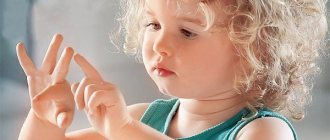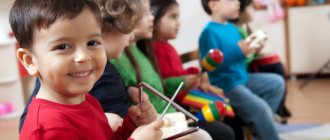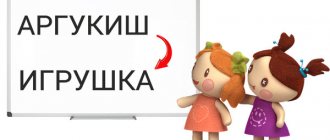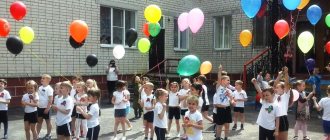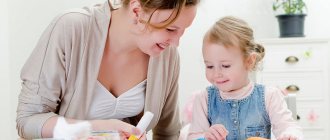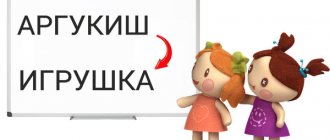Games for the social development of the personality of children 5-7 years old in kindergarten
Abstract: This system of games and exercises is aimed at the social development of the personality of a preschool child, in particular at the development and correction of the social development of the personality of older preschoolers.
A system of games aimed at the social development of the child’s personality Goal: development and correction of the social development of the personality of preschool children. Currently, the social development of the personality of a preschool child is becoming increasingly important. In preschool childhood, this is, first of all, mastering the norms of social life. The social development of a child is the most important prerequisite for the development of the spiritual and practical sphere of future activity of an adult, his moral character and creative potential. [9] Leading teachers Vygotsky L.S., Zaporozhets A.V., Spivakovskaya A.B., Elkonin D.B., Lisina M.I., Yakobson S.G. believe that a huge role in education and social development children belongs to the game. In the game, the moral foundations of the preschooler’s personality are actively formed, norms of social behavior are formed, which are subsequently transferred by children beyond the game. Play is a unique way of learning social experience, characteristic of preschool age. [8] Game therapy is a method of psychotherapeutic influence on children and adults using games.
The game has a stabilizing effect on personality development. [2] The level of emotional anxiety of older preschoolers can be corrected by introducing various collective outdoor games and games of a developmental nature into their life. Outdoor games have a positive effect on the development of feelings and emotions; the joy of movement is enhanced by the presence of fun situations and a competitive attitude.[3] It is recommended to work with an anxious child in three directions: increasing self-esteem, teaching the child the ability to control himself in the most worrying situations, relieving muscle tension, and also uniting the children's team. [1] Games to overcome anxiety and increase self-esteem in preschoolers.
1. Game “Balloon” Purpose: relieve tension, calm children. All players stand or sit in a circle. The presenter gives instructions: “Imagine that now you and I will inflate balloons. Inhale the air, bring an imaginary balloon to your lips and, puffing out your cheeks, slowly inflate it through parted lips. Follow with your eyes how your ball becomes bigger and bigger, how the patterns on it increase and grow. Introduced? I also imagined your huge balls. Blow carefully so that the balloon does not burst. Now show them to each other.” The exercise can be repeated 3 times. 2. Game “Portrait” Purpose: to teach the child to recognize emotions, relieve psychomuscular tension. The child sits opposite the adult. An adult in the role of an artist. “Now I will draw your portrait. But for this I need your help. I will name the parts of the face, and you will tell me how to draw them. For example, what size should I draw a face? More or less than yours? The child answers. What kind of eyes will there be - big or small, or will we leave the ones we have?” At the same time, the adult outlines the outline of the eyes in the drawing. “What color will they be?” The child calls. Then the nose, cheeks, ears, and hair are drawn in the same order. Eyebrows and lips expressing different emotions: joy, sadness, anger. Next, the child is asked to decide what mood this portrait will have. If a child identifies himself with a portrait, then he will reflect his own mood. If he does not reflect his true mood, it means that it has either moved from negative to positive, or the child is dissatisfied with himself and wants to change. 3. Exercise “Fight” Purpose: to relax the muscles of the lower face and hands. “You and your friend had a fight. A fight is about to start. Take a deep breath and clench your jaw tightly. Fix your fingers in your fists, press your fingers into your palms until it hurts. Hold your breath for a few seconds. Think about it: maybe it’s not worth fighting? Exhale and relax. Hooray! The troubles are over! This exercise is useful to carry out not only with anxious, but also with aggressive children. [6] 4. Game “Pump and Ball” Goal: relax the maximum number of muscles in the body. “Guys, break into pairs. One of you is a large inflatable ball, the other one inflates this ball with a pump. The ball stands with the whole body limp, on half-bent legs, arms and neck relaxed. The body is tilted slightly forward, the head is lowered (the ball is not filled with air). The friend begins to inflate the ball, accompanying the movement of his hands (they pump the air) with the sound “s”. With each supply of air, the ball inflates more and more. Hearing the first sound “s”, he inhales a portion of air, simultaneously straightening his legs at the knees; after the second “s”, his torso straightens; after the third, the ball’s head rises; after the fourth, his cheeks puff up and even his arms move away from his sides. The ball is inflated. The pump stopped pumping. A friend pulls the pump hose out of the ball... Air comes out of the ball with force with the sound “sh”. The body went limp again and returned to its original position.” Then the players change roles. [4] 5. Game “Bunnies and Elephants” Purpose: to enable children to feel strong and courageous, to help increase self-esteem. “Guys, I want to offer you a game called “Bunnies and Elephants.” At first, you and I will be little bunnies. Tell me, when a hare feels danger, what does it do? That's right, he's shaking. Show him how he shakes. He purses his ears, shrinks all over, tries to become small and unnoticeable, his tail and paws are shaking,” etc. Children show. “Show me what bunnies do if they hear a person’s steps?” Children scatter around the group, class, hide, etc. “What do bunnies do if they see a wolf?..” The teacher plays with the children for several minutes. “And now you and I will be elephants, big, strong, brave. Show how calmly, measuredly, majestically and fearlessly elephants walk. What do elephants do when they see a person? Are they afraid of him? No. They are friends with him and, when they see him, they calmly continue on their way. Show me how. Show what elephants do when they see a tiger...” Children pretend to be a fearless elephant for a few minutes. After the exercise, the guys sit in a circle and discuss who they liked to be and why. 6. Game “Magic Chair” Purpose: to help increase the child’s self-esteem and improve relationships between children. This game can be played with a group of children for a long time. First, an adult must find out the “history” of each child’s name - its origin, what it means. In addition, you need to make a crown and a “Magic Chair” - it must be high. The adult has a short introductory conversation about the origin of names, and then says that he will talk about the names of all the children in the group (the group should not be more than 6 people), and it is better to name the names of anxious children in the middle of the game. The one whose name is told becomes the king. Throughout the entire story about his name, he sits on a throne wearing a crown. At the end of the game, you can invite the children to come up with different versions of his name (gentle, affectionate). You can also take turns saying something good about the king. [7] 7. Game “Blind Dance” Goal: developing trust in each other, relieving excess muscle tension. “Get into pairs. One of you gets a blindfold, he will be “blind”. The other will remain “sighted” and will be able to drive the “blind”. Now hold hands and dance with each other to light music (1-2 minutes). Now switch roles. Help your partner tie the headband." As a preparatory step, you can sit the children in pairs and ask them to hold hands. The one who sees moves his hands to the music, and the blindfolded child tries to repeat these movements without letting go of his hands for 1-2 minutes. Then the children change roles. If an anxious child refuses to close his eyes, reassure him and do not insist. Let him dance with his eyes open. As the child gets rid of anxiety, you can start playing the game not while sitting, but moving around the room. 8. Game “Trains” Purpose of the game: development of communication skills, uniting children, increasing self-confidence and arbitrariness. A group of children is divided into threes, in each three the children stand one after another, holding their hands on the waist of the person in front. The first of them plays the role of a “train” (his eyes are closed and his arms are extended forward), the second is a “passenger,” and the third is a “driver.” The driver’s task is to control the locomotive and avoid collisions. The “passenger” is the transmission link of the “driver’s” commands to the “locomotive”. One of the group of children plays the role of a “dispatcher”; he sets the rhythm of the movement of the trains by clapping, speeding up or slowing down their movement. At the command of the leader, the trains begin to move, then after a while they stop on command, and the children and the trio change roles (the first becomes the third, etc.). It is important that all children experience three roles. It is advisable after the game to discuss with the children which role they liked best and why. [4] 9. Game “Theater of Masks” Goal: relax the facial muscles, relieve muscle tension and fatigue. "Guys! We will visit the “Theater of Masks”. You will all be artists, and I will be a photographer. I will ask you to portray the facial expressions of various characters. For example: show me what the evil Baba Yaga looks like.” Children, with the help of facial expressions and simple gestures, or only with the help of facial expressions, depict Baba Yaga. "Fine! Great! Now hold still, I’m taking pictures. Well done! Some even found it funny. You can laugh, but only after the shot has been shot. Now depict the Crow (from the fable “The Crow and the Fox”) at the moment when she squeezes the cheese in her beak.” Children clench their jaws tightly, simultaneously stretching their lips and pretend to be a beak. "Attention! Freeze! I'm filming! Thank you! Well done! Now show how scared the grandmother from the fairy tale “Little Red Riding Hood” was when she realized that she was not talking to her granddaughter, but to the Gray Wolf.” Children can open their eyes wide, raise their eyebrows, and open their mouths slightly. “Freeze! Thank you! And how slyly did Lisa smile when she wanted to please the bun? Freeze! I'm filming! Well done! Well done!” Further, the teacher or educator, at his own discretion, can praise particularly anxious children, for example, like this: “Everyone worked well, Vitya’s mask was especially scary, when I looked at Sasha, I was scared myself, and Mashenka looked very much like a cunning fox. Everyone did their best, well done!” “The actor’s working day is over. You and I are tired. Let `s have some rest. Let's sit quietly, relax and rest. Thanks to all!" [5] 10. Game “Change of Rhythms” Purpose: to help anxious children join the general rhythm of work, relieve excessive muscle tension. If the teacher wants to attract the attention of the children, he begins to clap his hands and count loudly, in time with the clapping: one, two, three, four... The children join in too, all clapping their hands together and counting in unison: one, two, three, four... Gradually the teacher, and after him the children, claps less and less, counts more quietly and slowly. 11. Game “Barbell” Purpose: to relax the muscles of the arms and back, to enable the child to feel successful. “Let's take a lighter barbell and lift it above our heads. You took a breath, raised the barbell, and fixed this position so that the judges counted your victory. It’s hard to stand like that, drop the barbell, exhale. Relax. Hooray! You are all champions. You can bow to the audience. Everyone is clapping for you, bow again like champions.” The exercise can be performed several times. 12. Game “Image of Animals” Goal: relax the facial muscles, relieve muscle tension.
A cunning fox, a cowardly hare, a terrible tiger, a strong bear and, conversely, a cowardly bear and a brave hare are depicted. [1] Games aimed at group cohesion.
1. Game “Mirror” A driver is selected: this is a person, all the others are mirrors. A person looks in mirrors, and they reflect him. The mirrors repeat all his movements, the actions of a man who, of course, grimaces from the heart. Here it is important to ensure that the mirrors reflect correctly: if a person raises his right hand, the mirrors should raise his left, etc. In this game, it is convenient to reward the most passive members of the group. [4] 2. Game “Give a card” An adult, together with the children, draws cards with pictograms indicating various positive qualities. It is necessary to discuss with the children what each pictogram means. For example, a card with a picture of a smiling person can symbolize fun. Each child is given 5-8 cards. At the leader’s signal, the children attach all the cards to their friends’ backs (using tape). The child receives this or that card if his comrades believe that he has this quality. At a signal from an adult, children stop playing and usually take the “prey” off their backs with great impatience. At first, of course, it happens that not all players have a lot of cards, but when the game is repeated and after discussion, the situation changes. During the discussion, you can ask the children if receiving cards is pleasant. Then you can find out what is more pleasant - giving good words to others or receiving them yourself. Most often, children say that they like both giving and receiving. Then the presenter can draw their attention to those who did not receive cards at all or received very few of them. Usually these children admit that they were happy to give cards, but they would also like to receive such gifts. As a rule, when the game is repeated, there are no “outcast” children left. 3. Game “Sculpture” This game teaches children to control the muscles of the face, arms, legs and relieve muscle tension. Children are divided into pairs. One of them is a sculptor, the other is a sculpture. On instructions from an adult (or child leader), the sculptor sculpts a sculpture from “clay”: a child who is not afraid of anything; a child who is happy with everything; a child who has completed a difficult task, etc. Topics for sculptures can be suggested by an adult, or by the children themselves. The players usually change roles. A group sculpture option is possible. After the game, it is advisable to discuss with the children how they felt in the role of a sculptor, sculpture, which figure was pleasant to depict, which was not. [5] 4. Game “Lavata” The players stand in a circle, hold hands and begin to move in a circle, singing loudly: “We dance, we dance, tra-ta-ta, tra-ta-ta, our cheerful dance is Lavata." Then everyone stops and the leader says: “My elbows are good, but my neighbor’s are better.” Everyone takes their neighbors by the elbows and starts moving again, singing. The presenter can name the body parts he wants (waist, shoulders, heels, legs, etc.), the main thing is to relieve tactile tension in the children. 5. Game “Toe-heel” (mini-training for getting closer and relieving tactile tension) Everyone stands in a circle very tightly, so that the toe rests on the heel of the person in front. When they stand up properly, everyone begins to slowly squat in this position - it turns out that everyone sits on the knees of the previous one. If you successfully sit down, you need to try to hold on for a while. 6. Game “Triangle, Square” Everyone stands in a circle and joins hands. Then everyone closes their eyes. The presenter asks: “Guys! In complete silence, without words, build me a triangle... square... rhombus, etc.” [1] 7. Game “Beep” The whole group, with the exception of the driver, sits in a circle on chairs or armchairs. The driver, blindfolded, walks inside the circle, periodically sitting on the laps of those sitting. His task is to guess who he sat with. You are not allowed to feel with your hands; you must sit with your back to the person sitting, as if you were sitting on a chair. The person sitting must say “Beep,” preferably “in a voice other than his own,” so as not to be recognized. If the driver guessed whose lap he is sitting on, then this child begins to drive, and the one who guessed sits in his place. 8. Game “Bug” The driver stands with his back to the group, putting his hand out from under his armpit with an open palm. The children and the psychologist stand in a line behind him. Everyone’s right hand is clenched and raised to chest level, the thumb of this hand is raised up. Someone from the line touches the open palm of the driver and quickly takes the starting position, and the driver must turn to the group and guess who touched him. The driver leads until he guesses correctly. Then the one you guessed starts driving. The game reveals group relationships well. [5] 9. Game “Confused” The driver is selected. He leaves the room. The rest of the children join hands and form a circle. Without unclenching their hands, they begin to get confused - as best they can. When a tangle has formed, the driver enters the room and untangles it, also without unclenching the hands of those who are entangled. The game promotes group unity. 10. Game “Birthday” Goal: to unite the group and create favorable emotional comfort in the group. Progress of the game: a birthday person is selected. Guests (children) are invited to come up with a congratulation and prepare a gift. You need to give a gift using gestures and facial expressions. One of the participants gives an imaginary “gift-image” to the birthday person, and everyone else must guess what was given to him. 11. Game “Blind Man’s Bluff” The game is aimed at group cohesion and initiation of tactile contacts, it is good for disinhibiting motorically inhibited children. The whole group stands in a circle, one person counts to choose the driver. The driver blindfolds himself, and someone from the group spins him in place to make orientation difficult. You can spin around with various funny sayings or comic dialogues. For example; “What are you standing on?” — “On the bridge.” — “What are you eating?” — “Sausage.” — “What are you drinking?” — “Kvass.” — “Look for mice, not us.” After this, everyone runs away, and the “blind man’s buff” must walk around the room and catch the children. Children run around the room, tease the blind man's buff, touch her to distract her, etc., and she must catch one of the children and guess who it is by touch. 12. Game “Desert Island” The game begins with sociometry - who will go with whom to a desert island. Then, when mutual and forced couples have formed, everyone goes to a desert island. Then the psychologists find themselves as natives on this island and attack pairs of children thrown out by the waves, causing aggression on themselves; they manage to unite the group well and relieve disappointment from sociometry. [4] Thus, the proposed games are aimed at the full social development of preschool children. The first group of games is aimed at overcoming anxiety and increasing the self-esteem of preschoolers. The second group of games is designed to unite and unite the children's team. The use of this system of games in correctional and developmental classes will be an effective means of social development of the personality of preschool children, which in the future will serve as protection for the child from social and interpersonal confrontations. Literature: 1. Correctional and developmental activities for children of senior preschool age. [Text] / E.A. Alyabyeva. - M.: “Academy”, 2003. 2. General psychology. Dictionary. [Text] / A. V. Petrovsky. – M.: Publishing house “PER SE”, 2005. 3. Rogov, E.I. Handbook for a practical psychologist. In 2 books. [Text] / E.I. Rogov—Kn. 1. - 2nd ed., revised. and additional — M.: Humanite. ed. 4. Safin, V.F. Mental deviations in the development of children and methods of their psychocorrection. [Text] / V.F. Safin. – Ufa: Kitap, 1994. – 80 p. center VLADOS, 1999.— 384 p.: ill. 5. Fopel, K. How to teach children to cooperate? Psychological games and exercises. In 4 volumes. [Text] / K. Fopel, trans. with German; T. 2. - M: Genesis, 1998. - 160 pp.: ill. 6. Workshop on children's correction: games, exercises, techniques. [Text] / O.N. Istratova. – Rostov N/D.: Phoenix, 2007. – 350 p. 7. The practice of psychotherapy: a collection of fairy tales, games and therapeutic programs. [Text] / N.A. Sakovich - St. Petersburg: Rech, 2007. - 227 p. 8. Bolotina, L.R. Preschool pedagogy. [Text] / L.R. Bolotina, S.P. Baranov, T.S. Komarova. – 2nd ed., rev. and additional — M.: Academic project; Culture, 2005.- 240 p. 9. Mukhina, V.S. Child psychology. [Text] /Ed. L.A. Wenger. –– M.: Education, 1985.- 272 pp., ill.
We recommend watching:
Intellectual game for children of senior preschool age Computer games for children 5-7 years old Puzzle game for preschool children 5-7 years old Logorhythmic exercises in verses for su-jok therapy on the lexical topic “Autumn”
Similar articles:
What are educational games for preschoolers
Outdoor games - tag for preschool children
Educational games in pictures for children 6-7 years old
Exercises to prepare the hand for writing for older preschoolers
Life safety games in the senior group
Card index of games on social and communicative development middle group card index (middle group)
Game card index
social and communicative
development middle group
"Name yourself"
Goal : To develop the ability to present oneself to a group of peers.
Progress: The child is asked to introduce himself, calling his name as he likes best, as he would like to be called in the group.
"Call me kindly"
Goal: to cultivate a friendly attitude among children towards each other.
Progress: The child is asked to throw a ball or pass a toy to his favorite peer (optional), affectionately calling him by name.
"Magic Chair"
Goal: to cultivate the ability to be affectionate, to activate gentle, affectionate words in children’s speech.
Progress: One child sits down, and the rest say kind, affectionate words about him.
"Magic wand"
Goal : continue to develop the ability to be affectionate.
Progress: Children stand in a circle. One child passes the stick to the person standing next to him and calls him affectionately.
"Freeze"
Goal: develop listening skills, develop organization.
Progress: The point of the game is the teacher’s simple command “Freeze,” which can be heard during children’s activities, in a variety of situations.
"Stream"
Goal: to develop the ability to act together and teach to trust and help those with whom you communicate.
Procedure: Before the game, the teacher talks with the children about friendship and mutual assistance, about how to overcome any obstacles. Children stand one after another and hold on to the shoulders of the person in front. In this position they overcome any obstacles.
"Magic wand"
Goal: developing ideas about the capabilities of one’s own and peers.
Move: One names the fairy tale, the other its characters, etc.
"Polite Words Store"
Goal: develop goodwill, the ability to establish contact with peers.
Progress: Educator: I have polite words on the shelf in my store: greetings (hello, good morning, good afternoon, etc.); affectionate addresses (dear mommy, dear mommy, etc.).
I will offer you various situations, and you buy the right words from me.
Situation. Mom brought apples from the store. You really want to, but mom said you need to wait until lunch.
How do you ask her to give you an apple?
"Body"
Goal: Continue to reinforce polite words.
Procedure: Children sit around a table on which there is a basket. The teacher turns to the child: “Here’s a box for you, put a polite word in it.”
"That's what grandma is like"
Goal: develop respect for elders, reinforce kind words.
Progress: Each child takes turns telling what his grandmother’s name is, and how affectionately you can call her.
"Wonderful bag"
Goal : expanding the volume of vocabulary, developing tactile perception and ideas about the characteristics of objects.
Progress: Children take turns recognizing the object by touch, naming it and taking it out of the bag.
"Good words"
Goal : develop the ability to use kind words in speech.
Progress: Children choose kind words. Show the children a picture of children working. What can you call children who work? (Hardworking, active, kind, noble, etc.)
"Rug of reconciliation."
Goal: develop communication skills and conflict resolution skills.
Progress: Coming from a walk, the teacher tells the children that two boys quarreled over a toy. Invites you to sit down opposite each other on the “rug of reconciliation” to find out the cause of the discord and find a way to peacefully resolve the problem. Discuss how to share the toy.
“What to do, what to do?”
Goal: to awaken children’s initiative, independence, intelligence, responsiveness, and willingness to look for the right solution.
Progress: Create a situation: there are no paints of certain colors, there is not enough plasticine for modeling. Children look for solutions on their own.
"Package"
Goal: expanding the vocabulary, developing coherent speech.
Progress: The child receives a package from Santa Claus and begins to describe his gift without naming or showing it. The item is presented after the children have guessed it.
“This is what Santa Claus is like”
Goal: develop respect, reinforce kind words.
Progress: The child tells what gifts Santa Claus brought, how he thanked him, how you can affectionately call him.
"Without a mask"
Goal: develop the ability to share your feelings, experiences, and construct unfinished sentences.
Progress: The teacher says the beginning of the sentence, the children must finish.
What I really want is...
I especially like it when...
One day I was really scared by...
"Day Night"
Goal: develop the ability to collaborate and achieve the desired result.
Progress: After the words “The day is coming - everything comes to life,” the participants in the game move chaotically and jump. When the teacher says: “Night comes, everything freezes,” the children freeze in bizarre poses.
“Listen outside the window, outside the door”
Goal: develop auditory attention.
Progress: According to the teacher’s instructions, all children focus their attention on the sounds and rustles of the corridor. Then they take turns listing and explaining what they heard.
"Who better to praise"
Goal: to be able to name the characteristics of animals based on the example of an adult, to develop attention and the ability to describe.
Procedure: The teacher takes a bear for himself and gives the child a bunny.
And he begins: “I have a bear.” Child: “And I have a hare.” etc.
"Who am I talking about"
Goal: to develop observation skills, the ability to focus on the main features of the described object.
Progress: The teacher describes the child sitting in front of him, naming his details of clothing and appearance. For example: “This is a girl, she’s wearing a skirt and blouse, her hair is blond, her bow is red. She loves to play with the Tanya doll."
"That's what dad is like"
Goal : develop respect for dad, reinforce kind words.
Progress: The child tells what his dad’s name is, how he plays with him, how he affectionately calls him.
"Describe a friend"
Goal: to develop attentiveness and the ability to describe what you saw.
Procedure: Children stand with their backs to each other and take turns describing the hairstyle, clothes, and face of their partner. Then the description is compared with the original and a conclusion is drawn about how accurate the child was.
“That’s what mom is like”
Goal: develop love for mom, reinforce kind words.
Progress: Each child takes turns telling what his mother’s name is, how she takes care of him, how she can be affectionately called.
"What changed?"
Goal: attentiveness and observation necessary for effective communication.
Move: The driver leaves the group. During his absence, several changes are made in the group (in the children's hairstyle, in clothes, you can move to another place), but no more than two or three changes.
"A gift for everyone"
Goal: to develop a sense of teamwork, the ability to make friends, to do
making the right choice to collaborate with peers.
Progress: The children are given the task: “If you were a wizard and could work miracles, what would you give to all of us now?”
"Why"
Goal : develop the ability to be friends and be polite.
Move: For example, if you offend a girl, she will cry.
If you accidentally pushed, then……………
You were given a toy, then……………
"Beat the transformation"
Goal : to cultivate trust in each other, a sense of responsibility for the other.
Move: The teacher passes an object (ball, cube) in a circle, calling them by conventional names. Children act with them as if they were objects named by an adult. For example, they pass a ball around in a circle. The presenter calls “Apple” - the children “wash”, “eat”, “sniff”, etc.
"Toys Alive"
Goal: to form a culture of communication in children.
Progress: Educator. You've probably been told or read fairy tales about how toys come to life at night. Please close your eyes and imagine your favorite toy, imagine what it does when it wakes up at night. Introduced? Then I suggest you play the role of your favorite toy. And we’ll try to guess what kind of toy you were depicting.
"Edible - inedible"
Goal : development of auditory attention, development of the ability to highlight the essential features of an object (edibility, animation).
Move: The leader says the word and throws a ball to one of the children and names the object. If edible, the player catches the ball, and if inedible, the player dodges the ball.
"Magic wand"
Goal: to form ideas about the capabilities of one’s own and peers, to consolidate the signs of spring.
Progress: Children pass the wand and name the signs of spring.
"Let's say hello"
Goal: to create a psychologically relaxed atmosphere in the group.
Progress: The teacher and children talk about different ways of greeting, real and comic. Children are encouraged to greet with their shoulder, back, hand, nose, cheek and come up with their own way of greeting.
"What can happen?"
Goal: develop imagination, strengthen the ability to finish a sentence, and the ability to listen to each other.
Progress: What could happen if……….
“All fairy-tale heroes will come to life.”
“The rain will continue to fall.”

